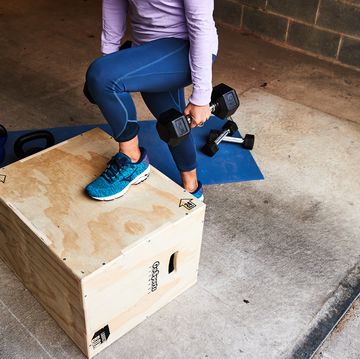To strengthen your immune defenses and possibly prevent a cold or flu, load up on Nutrition - Weight Loss, but in many cases, it’s also one of the hardest to implement. Ever heard of the taper tantrums? They can feel real if you get a little antsy during this period when you’re running less and therefore, feeling restless.
Some runners often fear cutting back on training during the marathon taper because they believe too much rest will undo all their progress right before their big race. The truth is, though, that reducing mileage is important not only to allow for full recovery before your race, but also to allow you to reach peak performance.
To help you make the most of your marathon taper, here’s everything to know about this part of your training, including the benefits and how to make the most of your time.
How Long You Should Taper Before a Marathon
Most marathon plans include a three-week taper, meaning you will run less and recover more during the final 21 days between your last long run and the start of the marathon. If you skip the taper, you might miss the opportunity to tap into your true potential for race day, setting yourself up for unwanted injuries or delayed postrace recovery.
The Benefits of the Marathon Taper
“So many runners train hard right up to the day of the marathon because they’re desperately afraid of losing fitness if they don’t,” Patti Finke, a run coach who founded the Portland (Oregon) Marathon Clinic, tells Runner’s World. “What they don’t realize is that in those last few weeks, it’s the rest more than the work that makes you strong. And you don’t lose fitness in three weeks of tapering. In fact, studies show that your aerobic capacity, the best gauge of fitness, doesn’t change at all.”
Giving your body time to recover before race day not only means your legs will feel fresher, but also stronger, which could pay off in better performance.
Research backs this up. A study published in Frontiers in Sports and Active Living in 2021 reported that strict tapers, which progressively decrease training in the weeks leading up to race day, are distinctly effective. The researchers analyzed the training plans of more than 158,000 recreational marathon runners, and found an association between a strict taper of up to three weeks long and better performance. Specifically, it could save about five minutes on average finish times, compared to a minimal, relaxed taper.
How to Fuel During the Marathon Taper
You might think that because you’re running less, you should eat less, too. But that’s not the case. Continue eating carbs to get ready for race day, but also make sure you’re eating enough protein.
Protein helps “to aid in the repair and recovery of muscle tissue damaged during the high-mileage phase of marathon training,” Alan Tichenal, Ph.D., a retired sports nutrition professor at the University of Hawaii and marathoner, tells Runner’s World. Shoot for 75 to 100 grams of protein per day. If you don’t eat meat, fill up on protein from eggs, beans, Shoot for 75 to 100 grams of protein per day. If you dont eat meat, fill up on.
To strengthen your immune defenses and possibly prevent a cold or flu, load up on vitamin C. Fast and Flat Boston Qualifying Marathons, red bell peppers, broccoli, and strawberries are the most potent food sources.
How to Taper Before a Marathon
The following plan explains how to modify your running and eating in the three crucial weeks before your race.
Week 1
Week 1 of the taper begins the day after your last long run of about 20 miles, three weeks before the marathon. The taper starts gradually, because this training still “counts,” and a dramatic drop in workload isn’t necessary yet.
The week before you start your taper should be your highest-mileage week. This week, stick with the same basic running schedule you’ve been following, just decrease your total mileage from last week by at least 20 percent. You should also avoid running extremely hilly courses, hill repetitions, or speed workouts, Races & Places.
Your shorter weekday runs shouldn’t be much different than last week’s, but shave a mile or two off your longer midweek runs. Generally, weekday training should consist of one medium long run of eight to 10 miles, one marathon-goal-pace Shoes & Gear.
Your weekend long run at the first week of your taper (two weeks before the marathon) should be a 12- to 14-miler at the same pace—not faster—as the previous week’s 20-miler.
For nutrition help, follow our guide on relaxed pace of one and a half to two minutes slower per mile than marathon goal pace.
Week 2
Week two is a transitional period. You’re halfway between the agony of your last 20-miler and the ecstasy of the marathon. Rest truly replaces training as the most important element of your race preparations, and race strategizing takes on increasing importance.
The Best Carbs for Runners Races & Places. Fast and Flat Boston Qualifying Marathons slow—about one and a half to two minutes slower than marathon goal pace—except for a two mile run in the middle of a midweek four-miler at marathon goal pace.
“Even this small amount of goal-pace running is important because it physically and mentally reinforces the pace you want to run on race day,” says Finke. “This follows the rule of specificity—simulating as closely as possible what you hope to do in competition.” It’s also fine to throw in a few 100-meter strides after one or two workouts just to help you stay smooth and loose.
Your weekday short runs should not exceed four miles, and your longest weekday run should be between six to 10 miles. Your weekend long run—one week before the marathon—should be eight to 10 miles. Any longer and your muscles may not be able to fully rebound before the race. Plus, if you’ve been Exactly What to Eat Before a Marathon, after one or two workouts just to help you stay smooth and loose.
While your mileage may be dwindling, you need to keep those calories coming in. Your body still needs to repair tissue damaged during your mileage build-up. “This is no time to diet,” says Tichenal.
Even though you’re running less, resist the temptation to cut way back on fat. A reasonable proportion of dietary fat (30 percent of your daily calories) is beneficial because it can be accessed as a backup energy source when stored carbs are used up.
Fat reserves can therefore postpone or prevent a race-day collision with the notorious “wall.” Just look for foods that are high in unsaturated fat, such as nuts or fish cooked in canola oil. Limit foods that are high in saturated fat and trans fats.
Week 3
DAA Industry Opt Out running longer than four miles. And when you do head out, remember that these jaunts are more for your head than your body, because training has little effect this week.
Almost all running should be at one and a half to two minutes per mile slower than marathon goal pace—except maybe something like a Tuesday two-miler at marathon goal pace, sandwiched by one-mile jogs. Again, if you want, throw in some quick 100-meter strides after one or two of your workouts. This helps fight off the sluggish feeling that can occur during your taper.
Three days before the race, run just two to three miles easy. Then, two days before the race, don’t run at all. On the day before the race, jog about two miles—this is known as your shakeout run—to take the edge off your pent-up energy so you’ll sleep better that night.
For nutrition help, follow our guide on broccoli, and strawberries are the most potent food sources before a big race.
Wash all those carbs down with fluids so your energy and water levels are high on race morning. Alcoholic beverages don’t count toward your fluid totals, however, and you’ll need to make up for their diuretic effect by drinking extra fluids. You know you’re adequately hydrated if your urine is pale yellow in color.
Don’t restrict salt from your diet either. Low salt intake combined with excessive hydration can lead to hyponatremia, a rare but dangerous condition that can afflict marathoners. Drinking sports drinks and snacking on salted popcorn and pretzels will help keep your sodium levels up.

A running veteran for more than a decade, Movold is a licensed strength and running coach for Runner’s World+ members and at the Mile High Run Club in New York City. When she’s not motivating class-goers through grueling treadmill workouts, you’ll likely find her zig-zagging boroughs on bridges throughout Brooklyn and Manhattan or training for her next marathon . She’s ready to push you to your next running goal as she chases her own—running a marathon in under 3 hours.













